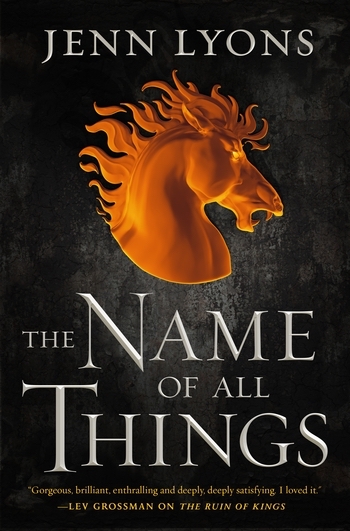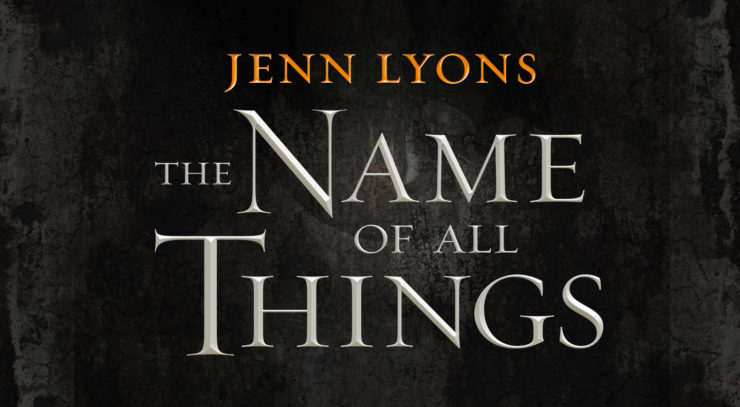Jenn Lyons’ A Chorus of Dragons series is a challenging one to review. With world-building that is not only deliciously complex but is also imaginative and ruthless in its exploration and interrogation of gender, sexuality, racism, and imperialism, it feels hard to know where to put my focus in a review. And so many beautiful details seem to slip through my fingers when I try to recall them all. Both with The Ruin of Kings and the series’ second installment, The Name of All Things, I almost felt like I needed to read the book several times before I could even adequately describe it, never mind critique it.
With that being said, The Name of All Things is not only a worthy successor to The Ruin of Kings, but actually surpasses it, both in technical execution and in the building of its characters. It helps, of course, that readers are now somewhat familiar with Lyons’ world, with its pantheon of gods and demons, complex politics, and fantastic mythology. But Lyons has also improved upon her narrative style, in which several characters are recounting one story to an outside listener. In The Ruin of Kings, Khirin and Talon recounted Khirin’s story to a magical recording stone. In The Name of All Things, Khirin is told the story of noblewoman Janel Theranon by both her and her companions, Dorna and Brother Qown, as they shelter together from a storm.
Oh, and also Janel wants Khirin to help kill a dragon.
Readers of the first book may remember how difficult it was for Khirin to just escape from Sharanakal—aka The Old Man—the music loving dragon who wanted to make Khirin part of his magical collection of stone singers, and you can imagine how much convincing the often-reluctant Khirin might need to consider this new task. But it’s not just a connection to dragons that Khirin and Janel share. Janel has also been tangled up with a demon, and like Khirin, she has been responsible for political upheaval and revolution—although in Janel’s case it is much more voluntary, whereas Khirin was dragged into it (often kicking and screaming) by his own mysterious past.
Janel shares some personality traits with Khirin as well. She is bold, snarky and very determined, and she quickly became one of my favorite characters. Her former nanny, Dorna, is absolutely delightful and Qown is what fandom would call a precious cinnamon roll that must be protected at all costs. Although the story’s focus is more on Janel in this book, Khirin still has time to shine, reminding us of the sassy boy we met in Ola’s velvet house and the courageous, resolute man he grew into by the end of The Ruin of Kings.
Janel’s story progresses more slowly than Khirin’s adventures did, with more lengthy explanations about political intrigue and cultural customs, but I found I enjoyed the reprieve from The Ruin of Kings’ break-neck pace, and it was easier to absorb all of Lyons’ wonderful details. Lyons continues to explore and expand upon the racist, sexist, and imperialistic nature of Quur, and also introduces us to Janel’s home, the nation of Jorat, where polyamory and queerness is common and expected. Janel herself is genderqueer, and the culture uses an interesting terminology referencing horses—“stallion, mare, gelding, foal”—to describe someone’s role in society. I enjoyed the fact that some of Jorat’s approach to queerness really appealed to me while other aspects made me uncomfortable—it is a complex culture with flaws as well as strengths, and terribly interesting to compare to the culture of Quur. The fact that Khirin is being introduced to the culture at the same time as the reader also helps with clarity as we learn about Jorat and Janel’s life there.
Buy the Book


The Name of All Things
Oh, and did I mention there’s a dragon?
Given the name of the series, I suppose no one is exactly surprised, but since Sharanakal was one of the most beautiful and intriguing aspects of The Ruin of Kings, I was happy to see another dragon show up. And Morios did not disappoint. Lyon’ imagination for creatures and cultures is matched beautifully by her talent for evocative and visual descriptions, and the tightening of the narrative structure in this book really made it the total package.
I am so pleased with the newest addition to A Chorus of Dragons and am very much looking forward to the next installment. In the meantime, I can definitely benefit from reading this one again. And probably again after that.
The Name of All Things is available from Tor Books.
Read an excerpt here.
Sylas K Barrett is an epic fantasy enthusiast and regular contributor here at Tor.com. You can find his initial review for The Ruin of Kings as well as his weekly read of The Wheel of Time here on the site.










